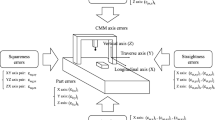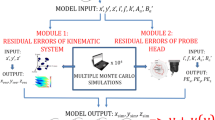Abstract
The measuring accuracy of coordinate measuring machines (CMMs) depends on different factors such as the errors associated to the CMM axis movement, the working table and other CMM elements. In order to estimate the measuring errors that can be present during the dimensional evaluation of mechanical components, the nature and relevance of the distinct factors involved in the inspection process should be properly identified, such as the position errors, straightness errors, part errors and other geometrical and dynamic deviations. The knowledge about the influence of the main errors related to the elements integrated in the CMM, can serve to estimate the expected accuracy during the geometrical evaluation of manufactured products or machinery components. In this work, the effect of position errors will be evaluated by separate in order to deduce the contribution of this factor to the resultant measuring accuracy. This study is oriented to the analysis of three-axis coordinate measuring machines, and distinct types of CMM axis errors will be discussed. The results shown in this work are focused on CMMs type FXYZ, although similar studies could be developed for other structural configurations.


















Similar content being viewed by others
References
Sładek, J., & Gąska, A. (2012). Evaluation of coordinate measurement uncertainty with use of virtual machine model based on Monte Carlo method. Measurement, 45, 1564–1575.
Zhang, G. (2012). “Error compensation of coordinate measuring machines”, chapter. In R. J. Hocken & P. H. Pereira (Eds.), Coordinate measuring machines and systems. Boca Raton: CRC Press.
Huang, P. S., & Ni, J. (1995). On-line error compensation of coordinate measuring machines. International Journal of Machine Tools and Manufacture, 35(5), 725–738.
Ramu, P., Yagüe, J. A., Hocken, R. J., & Miller, J. (2011). Development of a parametric model and virtual machine to estimate task specific measurement uncertainty for a five-axis multi-sensor coordinate measuring machine. Precision Engineering, 35, 431–439.
Sładek, J., Ostrowska, K., & Gąska, A. (2013). Modeling and identification of errors of coordinate measuring arms with the use of a metrological model. Measurement, 46, 667–679.
Thompson, M. N., & Cogdell, J. D. (2007). Measuring probe alignment errors on cylindrical coordinate measuring machines. Precision Engineering, 31, 376–379.
Meng, Z., Che, R. S., Huang, Q. C., & Yu, Z. J. (2002). The direct-error-compensation method of measuring the error of a six-freedom-degree parallel mechanism CMM. Journal of Materials Processing Technology, 129, 574–578.
Yang, P., Takamura, T., Takahashi, S., Takamasu, K., Sato, O., Osawa, S., et al. (2011). Development of high-precision micro-coordinate measuring machine: Multi-probe measurement system for measuring yaw and straightness motion error of XY linear stage. Precision Engineering, 35, 424–430.
Swornowski, P. J. (2014). A new concept of continuous measurement and error correction in Coordinate Measuring Technique using a PC. Measurement, 50, 99–105.
Echerfaoui, Y., El Ouafi, A., & Chebak, A. (2018). Experimental investigation of dynamic errors in coordinate measuring machines for high speed measurement. International Journal of Precision Engineering and Manufacturing, 19, 1115–1124.
Raghunandan, R., & Venkateswara Rao, P. (2008). Selection of sampling points for accurate evaluation of flatness error using coordinate measuring machine. Journal of Materials Processing Technology, 202, 240–245.
González-Madruga, D., Barreiro, J., Cuesta, E., & Martínez-Pellitero, S. (2014). Influence of human factor in the AACMM performance: A new evaluation methodology. International Journal of Precision Engineering and Manufacturing, 15, 1283–1291.
Curran, E., & Phelan, P. (2004). Quick check error verification of coordinate measuring machines. Journal of Materials Processing Technology, 155–156, 1207–1213.
Chanthawong, N., Takahashi, S., Takamasu, K., & Matsumoto, H. (2014). Performance evaluation of a coordinate measuring machine’s axis using a high-frequency repetition mode of a mode-locked fiber laser. International Journal of Precision Engineering and Manufacturing, 15(8), 1507–1512.
Jinwen, W., & Yanling, C. (2011). The geometric dynamic errors of CMMs in fast scanning-probing. Measurement, 44, 511–517.
Ahn, H. K., Kang, H., Ghim, Y.-S., & Yang, H.-S. (2019). Touch probe tip compensation using a novel transformation algorithm for coordinate measurements of curved surfaces. International Journal of Precision Engineering and Manufacturing, 20, 193–199.
Krajewski, G., & Wozniak, A. (2014). Simple master artefact for CMM dynamic error identification. Precision Engineering, 38, 64–70.
Savio, E., & De Chiffre, L. (2002). An artefact for traceable freeform measurements on coordinate measuring machines. Precision Engineering, 26, 58–68.
Acknowledgement
This manuscript is based upon work supported by Basic Science Research Program through the National Foundation of Korea (NRF) funded by the Ministry of Education (No. NRF-2020R1C1008728 & No. NRF-2020R1F1A1076549).
Author information
Authors and Affiliations
Corresponding author
Additional information
Publisher's Note
Springer Nature remains neutral with regard to jurisdictional claims in published maps and institutional affiliations.
Rights and permissions
About this article
Cite this article
Franco, P., Jodar, J. Theoretical Analysis of Measuring Accuracy of Three Linear Axis CMMs from Position Errors. Int. J. Precis. Eng. Manuf. 21, 2235–2247 (2020). https://doi.org/10.1007/s12541-019-00198-7
Received:
Revised:
Accepted:
Published:
Issue Date:
DOI: https://doi.org/10.1007/s12541-019-00198-7




